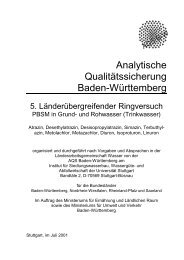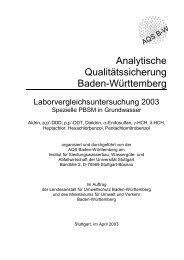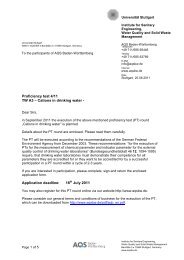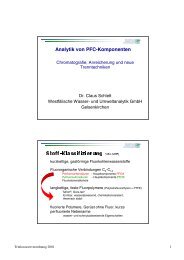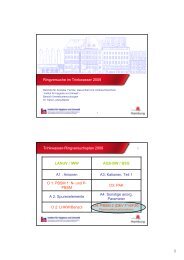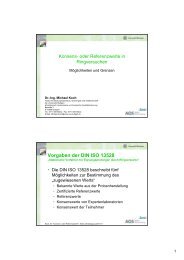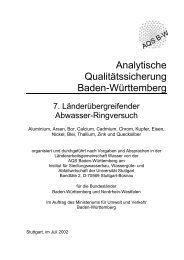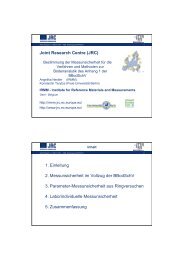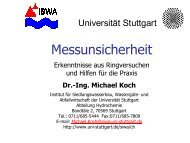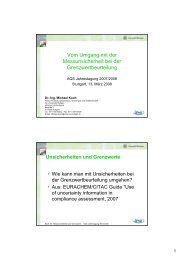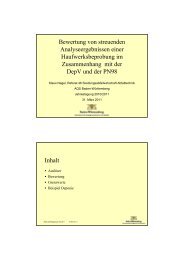Institute for Sanitary Engineering, Water Quality and Solid Waste ...
Institute for Sanitary Engineering, Water Quality and Solid Waste ...
Institute for Sanitary Engineering, Water Quality and Solid Waste ...
Create successful ePaper yourself
Turn your PDF publications into a flip-book with our unique Google optimized e-Paper software.
Chair of <strong>Sanitary</strong> <strong>Engineering</strong> <strong>and</strong> <strong>Water</strong> Recycling<br />
Subterranean Arsenic Removal: From Experiment<br />
to Delivery<br />
Together with the Indian applicant organisation Ramakrishna<br />
Vivekan<strong>and</strong>a Mission – <strong>Institute</strong> of Advanced<br />
studies (RKVM-IAS) the <strong>Institute</strong> <strong>for</strong> <strong>Sanitary</strong> <strong>Engineering</strong>,<br />
<strong>Water</strong> <strong>Quality</strong> <strong>and</strong> <strong>Solid</strong> <strong>Waste</strong> Management<br />
(ISWA) of the University of Stuttgart is implementing<br />
the project “Subterranean Arsenic Removal: From Experiment<br />
to Delivery”. The objective of this project is<br />
to reduce in an af<strong>for</strong>dable <strong>and</strong> sustainable manner the<br />
health consequences of arsenic contaminated water<br />
in rural communities of West Bengal, India by in-situ<br />
treatment of groundwater. Within the project six insitu<br />
treatment plants shall be established. The in-situ<br />
treatment plants shall be manufactured <strong>and</strong> distributed/serviced<br />
by local entrepreneurs. Further on they<br />
shall be managed by self-sustained community groups<br />
with the support of classroom <strong>and</strong> h<strong>and</strong>s-on training.<br />
Development of strategies <strong>for</strong> water circuit closure<br />
<strong>for</strong> selected industries with split flow concept<br />
Most industries used to treat or pre-treat the cumulative<br />
waste waters of a factory, targeting in some cases<br />
<strong>for</strong> a partial recycling. Some factories collect waste<br />
waters according to their origin <strong>and</strong> treat these waste<br />
waters independently. Nonetheless, often waste waters<br />
are thereby blended from individual sources, differing<br />
greatly in quantity <strong>and</strong> quality.<br />
These blend waste waters are often difficult to be purified,<br />
since the waste water constituents may vary<br />
greatly. The treatment steps needed <strong>for</strong> a purification<br />
of such waste waters will become complex <strong>and</strong> dem<strong>and</strong>ing,<br />
mastering all eventualities. Thus, a recycling<br />
of waste waters is not considered <strong>for</strong> economical reasons.<br />
Paper industry<br />
Main focus was given to the application of membrane<br />
processes, mainly ultrafiltration <strong>and</strong> nanofiltration.<br />
Ultrafiltration is much less costly than nanofiltration,<br />
but only with nanofiltration <strong>and</strong> reverse osmosis solute<br />
salts can be removed. Therewith, an effective sink is<br />
created <strong>for</strong> the removal of salts, accumulating in the<br />
circuits otherwise. Thus, with nanofiltration or reverse<br />
osmosis applied, water circuits can be concentrated or<br />
even closed, without deteriorating product quality.<br />
Research is conducted both with waste waters from<br />
paper mills producing white paper <strong>and</strong> mills producing<br />
brown paper.<br />
Fig.:<br />
Pump room with tanks <strong>for</strong> oxygenation <strong>and</strong> degasification<br />
Financing institution:<br />
World Bank under Development Marketplace 2006<br />
Project partner:<br />
1. Queen’s University Belfast - School of Chemical<br />
<strong>Engineering</strong> <strong>and</strong> Queen‘s University Environmental<br />
Science <strong>and</strong> Technology Research Centre<br />
(Questor Centre), Großbritannien<br />
2. University of Stuttgart, Germany<br />
3. Ramakrishna Vivekan<strong>and</strong>a Mission – <strong>Institute</strong> of<br />
Advanced studies (RKVM-IAS)<br />
Contact:<br />
Prof. Dr.-Ing. U. Rott<br />
Dipl.-Ing. Ralf Minke, AOR<br />
Dipl.-Ing. Manuel Krauß<br />
The corresponding water circuits differ significantly in<br />
respect to organic <strong>and</strong> inorganic waste water constituents.<br />
The COD-levels in the water circuits <strong>for</strong> instance<br />
are usually more than 10 times higher in mills producing<br />
brown paper as they are in mills producing white<br />
paper. The same applies to the concentration of soluble<br />
salts, expressed in terms of conductivity, with a<br />
factor of at least 5.<br />
Besides the research on finding suitable membranes<br />
<strong>and</strong> membrane combinations, focus is also given on<br />
where to apply membrane processes. Biologically treated<br />
water is usually easier to treat with membranes,<br />
yet resulting in large amounts of concentrates to be<br />
disposed. A membrane step close to the production,<br />
i.e. the direct filtration of waste waters from the water<br />
circuits, can result in a more cost-effective configuration<br />
of subsequent biological treatment steps <strong>for</strong> the<br />
resulting concentrates, since smaller streams with higher<br />
concentration levels can be applied to <strong>for</strong> example<br />
52




